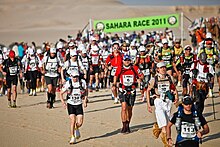
Back Ultramaraton Afrikaans ألترا ماراثون Arabic Ултрамаратон Bulgarian Ultramarató Catalan Ultramaraton Czech Ultramaratonløb Danish Ultramarathon German Ultramaraton DIQ Υπερμαραθώνιος Greek Ultradistanca kuro Esperanto
This article has multiple issues. Please help improve it or discuss these issues on the talk page. (Learn how and when to remove these messages)
|
 Ultramarathoners compete at the Sahara Race 2011 (4 Deserts) | |
| Highest governing body | World Athletics, International Association of Ultrarunners, and the Global Organization of Multi-Day Ultramarathoners |
|---|---|
| Presence | |
| World Championships | 1987–present |
An ultramarathon is a footrace longer than the traditional marathon distance of 42.195 kilometres (26 mi 385 yd). The sport of running ultramarathons is called ultra running or ultra distance running.
Various distances, surfaces, and formats are raced competitively, from the shortest common ultramarathon of 31 miles (50 km) and up to 3100 miles.[1] Around 100 miles (160 km) is typically the longest course distance raced in under 24 hours, but there are also longer multiday races commonly held as 48 hours, 200 miles (320 km), or more, sometimes raced in stages with breaks for sleep.
The oldest and largest ultramarathons are on road, including the Comrades Marathon (over 10,000 finishers annually) and Two Oceans Marathon (over 6,000 finishers annually).[2] The world's longest certified footrace is the Self-Transcendence 3100 Mile Race. Many ultras have historical significance, including the Spartathlon, based on the 246 km run of Greek messenger Pheidippides from Athens to Sparta during the Battle of Marathon in a day and a half to seek aid against the Persians.[3][4][5]

Ultra running World Championships are held by the International Association of Ultrarunners (IAU) for 50 km, 100 km and 24 hours. The Global Organization of Multi-Day Ultramarathoners (GOMU) holds World Championships for 48 hours and six days.[6] World records are ratified and recognized by World Athletics (50 km and 100 km), the IAU (50 km up to six days), and by GOMU (48 hours up to 5000 km).[7][8][9]
There is also overlap with the sports of trail running and mountain running. Some 100-mile (160 km) races are among the oldest and most prestigious events, especially in North America.[10] The oldest and also the largest trail race is the SainteLyon 78-kilometre (48 mi) in France (over 5,000 finishers annually).[11] Many ultramarathon organizers are members of the International Trail Running Association (ITRA), an organization that evaluates the difficulty of specific ultramarathon routes according to a number of criteria, such as the distance, the cumulative elevation gain, and the number of loops and stages.[citation needed]
- ^ "The 27th Annual Sri Chinmoy Self-Transcendence 3100 Mile Race - 3100 Mile Race". 3100.srichinmoyraces.org. Retrieved 22 October 2023.
- ^ "DUV Ultra Marathon Statistics". statistik.d-u-v.org. Retrieved 4 October 2023.
- ^ Spartathlon (28 August 2015). "Ιστορικά Στοιχεία". Spartathlon Ultra Race (in Greek). Retrieved 23 October 2023.
- ^ "Spartathlon Part 1 (1982) - The Birth | Ultrarunning History". 19 September 2021. Retrieved 23 October 2023.
- ^ Holmes, Katie (30 September 2022). "Eleanor Adams and the first Spartathlon". RunYoung50. Retrieved 23 October 2023.
- ^ "GOMU - Global Organization of Multi-Day Ultramarathoners - World Championships". www.gomu.org. Retrieved 28 October 2023.
- ^ "World Athletics". worldathletics.org. Retrieved 22 October 2023.
- ^ Bedkowski, Jacek. "Rankings & Records". IAU - International Association of Ultrarunners. Retrieved 22 October 2023.
- ^ "GOMU - Global Organization of Multi-Day Ultramarathoners - Results & Records". www.gomu.org. Retrieved 23 October 2023.
- ^ "First Finishers of Western States 100 Trail on Foot". 9 February 2022. Retrieved 23 October 2023.
- ^ "DUV Ultra Marathon Statistics". statistik.d-u-v.org. Retrieved 8 February 2024.